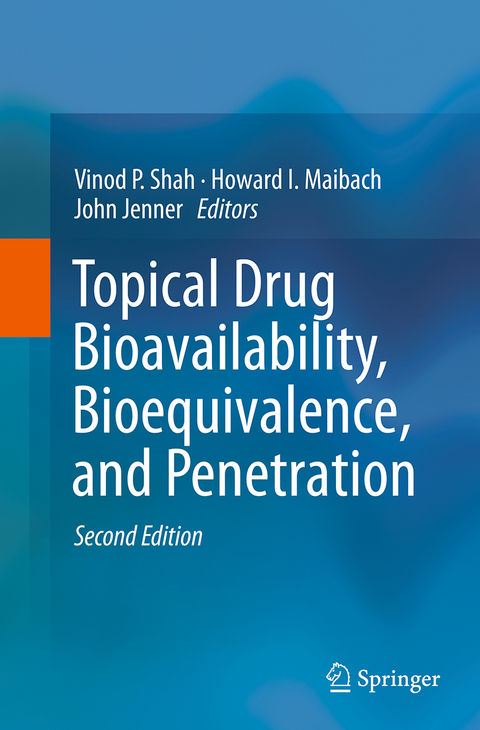
Topical Drug Bioavailability, Bioequivalence, and Penetration
Springer-Verlag New York Inc.
978-1-4939-3856-8 (ISBN)
The first edition of this book was an important reference guide for researchers working to define the effectiveness and safety of drugs and chemicals that penetrated the skin. This second edition contains cutting-edge advances in the field and is a key resource to those seeking to define the bioavailability and bioequivalence of percutaneously active compounds to improve scientific and clinical investigation and regulation.
Vinod P. Shah is a pharmaceutical consultant. He was Scientific Secretary of International Pharmaceutical Federation (FIP) and is now Chair of Regulatory Sciences Special Interest Group of FIP. Dr. Shah has served at the U.S. Food and Drug Administration and has developed several regulatory guidances for the pharmaceutical industry in biopharmaceutics and topical drug products. Dr. Shah is a fellow of FIP as well as the American Association of Pharmaceutical Scientists (AAPS), where he served as president for a year. He is a recipient of an honorary doctorate from Semmelweis University, Budapest, Hungary. Howard I. Maibach is professor of dermatology at the University of California, San Francisco. He received his M.D. at Tulane University Medical School in New Orleans, Louisiana, and completed his residency and research fellowships at the University of Pennsylvania in Philadelphia, Pennsylvania. Professor Maibach is a leading authority in the fields of dermatotoxicology and dermatopharmacology, in which he has conducted research and written extensively. Prof. Maibach has served on the editorial boards of more than thirty scientific journals and is a member of many professional societies, including the American Academy of Dermatology and the International Commission on Occupational Health. John Jenner is a principal scientist at The Defence Science and Technology Laboratory in the UK. He has a degree in pharmacology from the University of Manchester in Manchester, UK, and a Ph.D. from the University of Surrey, Guildford, UK. John has spent his career studying defense against and treatment of highly toxic chemicals. He has an enduring research interest in percutaneously active chemicals, whether toxic materials or drugs, and experience in the design and testing of transdermal formulations. His current interests include the translation of in vitro penetration measurements to in vivo using mathematical modelling.
1 Percutaneous Absorption.- 2 Animal Models for Percutaneous Absorption.- 3 Mitigating Dermal Exposure to Agrochemicals.- 4 Importance of In Vitro Drug Release.- 5 Diffusion Cell Design.- 6 In Vitro Product Quality Tests and Product Performance Tests for Topical and Transdermal Drug Products.- 7 Safety and efficacy testing of topical products; Practical considerations.- 8 Challenges in Evaluating Bioequivalence of Topical Dermatological Drug Products.- 9 Methods for the Assessment of Bioequivalence of Topical Dosage Forms: Correlations, Optimization Strategies and Innovative Approaches.- 10 Application of Microdialysis in Assessing Cutaneous Bioavailability.- 11 Follicular Drug Penetration.- 12 Development of Pilosebaceous Unit-Targeted Drug Products.- 13 Deep Percutaneous Penetration into Muscles and Joints: Update.- 14 Efficacy & Toxicity of Microneedle based devices.- 15 Mathematical Models for Topical and Transdermal Drug Products.- 16 Transdermal Patches: An Industrial Perspective on the Relevance of in vitro Skin Permeation Studies and Approaches on Design of Manufacturing Processes.- 17 Transdermal Drug Delivery Systems. Regulatory Considerations: NDA and ANDA Requirements.- 18 Transdermal Estradiol and Testosterone Transfer in Man: Existence, Models, and Strategies for Prevention.- 19 Effects of occlusion on dermal drug delivery: implications for bioequivalence measurement.- 20 Challenges with Clinical Endpoints – Bioequivalence.- 21 Clinical Considerations of Bioequivalence For Topical Dermatologic Drugs.- 22 OECD Test Guideline 428 – A method for in vitro percutaneous absorption measurement?.- 23 Bioequivalence, Quality, and Novel Assessment Technologies for Topical Products: Current Challenges and Future Prospects.
| Erscheinungsdatum | 14.10.2016 |
|---|---|
| Zusatzinfo | 16 Illustrations, color; 48 Illustrations, black and white; XIII, 402 p. 64 illus., 16 illus. in color. |
| Verlagsort | New York |
| Sprache | englisch |
| Maße | 155 x 235 mm |
| Themenwelt | Medizin / Pharmazie ► Medizinische Fachgebiete ► Pharmakologie / Pharmakotherapie |
| Medizin / Pharmazie ► Pharmazie | |
| Naturwissenschaften ► Biologie ► Zoologie | |
| Naturwissenschaften ► Physik / Astronomie ► Angewandte Physik | |
| Schlagworte | Bioavailability • bioequivalence • Drug Release • Penetration • quality test • topical drugs |
| ISBN-10 | 1-4939-3856-8 / 1493938568 |
| ISBN-13 | 978-1-4939-3856-8 / 9781493938568 |
| Zustand | Neuware |
| Informationen gemäß Produktsicherheitsverordnung (GPSR) | |
| Haben Sie eine Frage zum Produkt? |
aus dem Bereich


